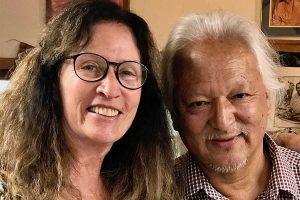Two painters twist traditions to create contemporary Buddhist artworks
13 Dec 2019
Making Modern Deities
By Kerry Parry A thangka is a Tibetan painting that depicts a Buddhist deity, often surrounded by associated gods, and describes events or myths related to religious teachings. Thangkas are made with mineral pigments applied to cotton or silk, and they also depict a particular deity’s realm as a mandala. Strict traditions define the methods, layout, dimensions and materials used to create these depictions. According to Norbulingka Institute in India, which teaches the art of thangka, “The proportions are considered sacred, as not only are they exact representations of Buddhist deities, but also the visual expression of spiritual realizations that occurred at the time of a vision.” Aspiring thangka artists spend years studying the iconographic grids and proportions of different deities, and then master the technique of mixing and applying mineral pigments.












